Microsoft had its big Windows 10 Event in New York City on Wednesday, with several major product launches and unveilings. From watching the livestream and tracking coverage from RCP Editor at Large Jeff Schwartz who was on site, here are the big takeaways, especially for Microsoft partners.
This Was a 'Consumer' Day
Most, though not all, of Microsoft's announcements on Wednesday were aimed at consumers, in the sense of home users and gamers. Much of it also applied to students and educators, but the main overlap for business customers is in any department that employs creative professionals, who did have plenty to chew on. If some of the new products take off, they could give Microsoft a way to claw its way into the creative professional space that Apple has used as its beachhead into the business market. But for those looking for deployment advancements, system management, security improvements, et cetera, this wasn't your day.
Next on the Windows Roadmap: Windows 10 Creators Update
The word of the day was "creators," and it featured most prominently in the next version of Windows, which will ship in spring 2017 and be called Windows 10 Creators Update. In accordance with the Windows 10 business model, the update will be free for current users of Windows 10. Among the new features will be widespread support of 3-D technology within a new version of Paint (Paint 3D) and the Microsoft Edge browser. Demos included people quickly making holograms, and videos showed users sending creations off to 3-D printers.
Terry Myerson, executive vice president of the Windows and Devices Group at Microsoft, declared a wildly ambitious goal for the new version. He said that with the Creators Update, Microsoft wants to have the effect of the Gutenberg Press on the computing industry.
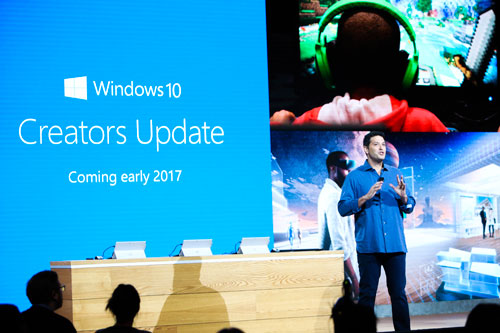 Microsoft Executive Vice President Terry Myerson announces the Windows 10 Creators Update.
Microsoft Executive Vice President Terry Myerson announces the Windows 10 Creators Update.
Big Hardware Reveal: Surface Studio
The major product launch Wednesday was the Surface Studio, which Microsoft Surface chief Panos Panay declared is the next category-creating device out of his team. Similar to an all-in-one PC (especially similar to Apple's all-in-one iMac), the Studio distinguishes itself with a huge 28-inch, yet very thin, touchscreen and two chrome arms that allow it to be folded down to a low angle for drawing. High-powered with 192 DPI resolution, the Studio will start at $2,999. According to the Microsoft Store, the Studio will start shipping in mid-December. Panay said it would be available in limited quantities for the holidays.
 Surface Studio
Surface Studio
Little Hardware Reveal: Surface Dial
A new device that goes with the Surface Studio but can also be used in a limited way with the Surface Book and the Surface Pro is the Surface Dial. The $100 device is shaped like a short cylinder, similar in size to an Amazon Echo Dot. The Dial represents a new method of user input in addition to the mouse, pen, touch, keyboard and voice. For the Studio, the Dial can be placed directly on the screen to light up new interface options (see the image below). For other Surface hardware, the Dial stays on the desk for scrolling, zooming and navigating.
 Surface Dial
Surface Dial
MIA #1: Surface Phone
There has been a lot of speculation that Microsoft might be on the cusp of releasing a Surface Phone that was somewhere on the phablet spectrum between a little tablet and a big phone. The new Windows 10 Mobile phone from HP, the HP Elite x3, made an appearance, but there were no signs or hints of a Surface Phone on Wednesday.
MIA #2: Surface Pro
A likely candidate for an update was the successful Surface Pro, but Microsoft chose not to refresh it ahead of the holiday season. Surface Pro 4 remains the top of the line.
Surface Book Gets Some Attention
Surface Book did get an update in New York, although not a fully numbered release (as in becoming the Surface Book 2). Microsoft's laptop with the removable and reversible screen got a new base and new processors. The three new models are branded Surface Book with Performance Base, and major feature improvements include i7 processors, a doubling of graphical processing power and a claimed 16-hour battery life. The Performance Base models start at $2,399 and will begin shipping Nov. 10.
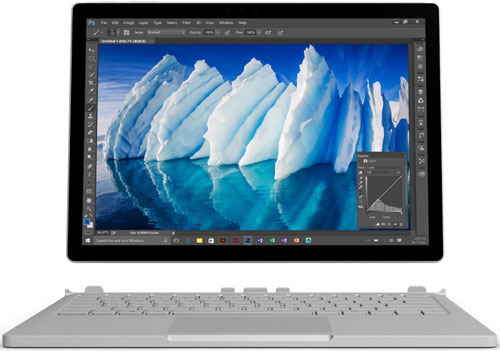 Surface Book with Performance Base
Surface Book with Performance Base
Showing Off with PowerPoint
Microsoft plans to integrate 3-D technologies into many of its apps over the next year. To show what's coming, Microsoft did a demo on Wednesday with PowerPoint. The process of dragging in 3-D objects and building in animated motion of the objects appeared to be simple and quick. In automated slideshow mode, the presentation looked more like a graphical short film than a traditional slide deck.
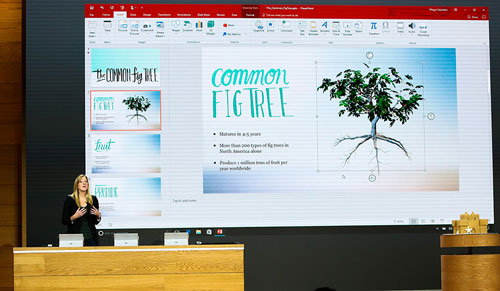 Microsoft's Heather Alekson demonstrates Windows 10's 3-D capabilities using a PowerPoint presentation as an example.
Microsoft's Heather Alekson demonstrates Windows 10's 3-D capabilities using a PowerPoint presentation as an example.
From Smartphone Camera to 3-D Model
Microsoft General Manager Megan Sanders gave one of the best demos of the day when she used the camera of an HP Elite x3 smartphone running Windows 10 Mobile to create a 3-D model of a real-world object. Walking slowly around a sand castle, Sanders captured a 3-D image that she was then able to manipulate and combine with other elements from within Paint 3D. While the demo involved a phone using Windows 10 Mobile, Sanders said of the Windows Capture 3D Experience: "We envision this experience on any device."
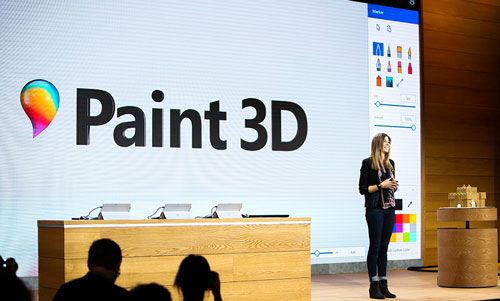 Microsoft's Megan Sanders demos Paint 3D.
Microsoft's Megan Sanders demos Paint 3D.
OEMs Getting into Microsoft's Mixed Reality Game
When it comes to the augmented-reality/mixed-reality experiences that Microsoft wants developers to create and users to enjoy, the Microsoft HoloLens won't be the only option for viewing them. Microsoft on Wednesday announced that HP, Lenovo, ASUS, Dell and Acer will ship mixed-reality-capable headsets for use with the Creators Update in 2017. Myerson said the accessories would start at $299.
Posted by Scott Bekker on October 26, 20160 comments
In the wake of a massive botnet attack from infected Internet of Things (IoT) devices last week, Microsoft on Wednesday unveiled a limited release of a new Security Program for Azure IoT that involves working with and recommending certain partners to audit customers' IoT implementations.
"This new program brings together a curated set of best-in-class security auditors customers can choose from to perform a security audit on their IoT solutions, find issues and provide recommendations. The Security Program for Azure IoT will work from the ground up, examining everything from a businesses' devices and assets to gateways and even communication to the cloud," wrote Sam George, partner director of program management for Microsoft's Azure IoT, in a blog post announcing the program.
George's post doesn't specifically reference the massive distributed denial of service (DDoS) attack on Friday against Dyn DNS. For users in the northeastern United States, and elsewhere as the day wore on, the domain name service outage took down major Internet services, such as Amazon, Netflix, Twitter, PayPal, Reddit, GitHub and Spotify.
Security researchers tied the outage to the Mirai malware, which scans for IoT devices like routers and cameras still using factory-default passwords and then infects them with malware. The ability to build botnets out of so many of the inexpensive IoT devices is leading to DDoS attacks of unprecedented scale.
The timing of Microsoft's announcement and the fact that the program is a limited release for "select Azure IoT" customers suggests Microsoft may have moved up the unveiling of the program in response to the notoriety the attack has caused for the emerging IoT market.
Initial security auditing partners in the program are Casaba Security LLC, CyberX, Praetorian and Tech Mahindra.
"In the coming months, we'll continue to provide updates on the Security Program for Azure IoT, our global auditing partners, and auditing standards," George said. "This is part of our commitment to establish a vibrant and safe IoT ecosystem."
Posted by Scott Bekker on October 26, 20160 comments
A strong earnings report from Microsoft on Thursday shot MSFT shares to record levels, largely on cloud growth and revenues. The investor call after the release had some interesting nuggets for Microsoft partners. Some of the key quotes from Microsoft CEO Satya Nadella and CFO Amy Hood:
1. "Surface continues to drive category growth and more commercial customers are choosing to deploy Surface, with deals of five hundred devices or more increasing 70 percent year-over-year. And we are reaching more commercial customers of all sizes with the support of our channel partners." --Nadella
For the first quarter, Microsoft Surface revenues increased 38 percent to a reported $926 million. Those are great numbers for the category-creating devices, and Microsoft is pointing to the channel and to substantial enterprise deals for the strength. There are a lot of comparisons out there to Apple iPad sales, but it's a complicated comparison. Surface Pro 4 competes with iPad Pro, which is a fraction of all iPad sales. On the other hand, the Surface Book, which is included in the Surface revenues, competes more with other PCs and with Macs.
Even with the expected launch of more Surface devices soon, don't look for similar good news in Q2. Hood warned that Microsoft expects Surface revenues to decline in the current quarter.
2. "Our commercial cloud annualized revenue run rate now exceeds $13 billion, and we remain on track to achieve our goal of $20 billion in fiscal year '18." --Nadella
The $20 billion cloud run rate was a big promise, and it's a strong sign for the channel that Microsoft is still discussing that goal as a realistic number that it is still aiming to hit. For the record, Microsoft says it calculates that run rate by multiplying revenue for the last month of the quarter by 12 for Office 365 commercial, Azure, Dynamics online and "other cloud properties."
Boosting the run rate were a 116 percent improvement in Azure revenues, a 20-point year-over-year gain in the percentage of Fortune 500 companies running at least three of Microsoft's cloud offerings (now 60 percent). Not to mention the Office 365 commercial cloud...
3. "Monthly active users of Office 365 commercial are now over 85 million, up more than 40 percent year-over-year. Office 365 commercial seats were also up 40 percent year-over-year, and revenue up 54 percent in constant currency." --Nadella
For partners wondering where the baseline is -- that's it. Microsoft is growing seats by 40 percent and growing revenues by 54 percent. The revenue growth has to do with revenue-per-seat improvements by moving customers to multiple workloads and into higher SKUs like E3 or E5.
4. "Dynamics CRM Online paid seats more than doubled year-over-year. And customers increasingly prefer our cloud solutions, with more than 70 percent of new Dynamics CRM and ERP enterprise customers choosing Dynamics online." --Nadella
The new customer addition number is interesting and helps explain Microsoft's huge launch of Dynamics 365 next month. Don't be surprised to see a tail-off in these numbers in Q2, due to widespread confusion in the channel about the pricing cutover to Dynamics 365 on Nov. 1 and some gaps in product availability in the early rollout phase.
5. "More than half of the Fortune 500 have our Enterprise Mobility services, up more than 20 points year-over-year. ... And we crossed three-quarters-of-a-billion unique user identities in Azure Active Directory." --Nadella
In short, enterprise mobility, still a focus.
6. "We continue to see strong interest in the preview for SQL Server on Linux with 19,000 customers registered, including more than half of the Fortune 500. It's opening conversations with customers spanning their entire data estate both on-premises and in the cloud." --Nadella
SQL Server on Linux is only one of the Linux and open source projects Nadella mentioned. He also talked about open sourcing Windows PowerShell and Azure Service Fabric on Linux. Especially for enterprise partners, being part of the open source conversation is becoming key.
7. "As expected, Enterprise Services revenue growth slowed this quarter to 1 percent and 2 percent in constant currency, largely due to a decreasing volume of support agreements associated with Windows Server 2003 end-of-support." --Hood
The ebb and flow of Microsoft's services efforts are always of interest to partners concerned about conflict with Microsoft's internal services arm. From an earnings perspective, it's looking like an ebb period.
Posted by Scott Bekker on October 21, 20160 comments
New York-based CafeX Communications will be Microsoft's preferred solution provider for omnichannel engagement within the soon-to-be-released Dynamics 365 for Customer Service application, the companies announced Wednesday.
Dynamics 365 for Customer Service is one of the five initial applications coming in the Enterprise edition of Dynamics 365, which is set for availability on Nov. 1. Dynamics 365 is Microsoft's new flagship business application platform that serves both ERP and CRM functionality from the Azure cloud.
The add-on will be called LiveAssist for Dynamics 365 powered by CafeX and will be available slightly later than the underlying Microsoft application. A trial version is set for release in November, with general availability set for Jan. 31, 2017. That initial release will feature live chat and co-browsing, which allows an agent to see and assist with pages and forms that a customer is viewing.
CafeX will follow that release with click-to-call, audio call and video call capabilities, to be delivered later in 2017, CafeX Chief Marketing Officer Sajeel Hussain said in a telephone interview Wednesday. The list price for the LiveAssist capabilities in Dynamics 365 will be $49 per agent per month for chat and co-browsing, and $65 per agent per month for all the communications channels, Hussain said.
Microsoft and CafeX have been working together on bringing CafeX's LiveAssist technology to the Dynamics 365 platform for about nine months, he said.
"We have tightly integrated our solution with Dynamics 365 in such a way that all of those experiences are seamless across the stack. If an agent is in our console, they don't have to leave our console. If an authenticated chat comes in, the case record pops up -- the agent doesn't have to go back and forth between the different consoles. Intelligence is shared between the chat console and Dynamics."
Hussain described three key elements of the partnership: hosting of the CafeX solution in the Azure cloud, the immersive integration, and a joint CafeX-Microsoft roadmap for engineering and go-to-market efforts.
In a statement, Jujhar Singh, corporate vice president of Microsoft Dynamics CRM, said omnichannel was at the heart of successful customer engagement solutions and confirmed CafeX's position as a preferred solution provider for the technology.
"Enterprises can now extend real-time assistance within the context of business processes to create more unified and intelligent customer journeys," Singh said.
Posted by Scott Bekker on October 19, 20160 comments
Bill Belichick is known for his terse responses at news conferences. Which is why it was surprising when the New England Patriots head coach went on for more than five minutes about his frustrations with stadium technology during games, including the Microsoft Surface.
"As you probably noticed, I'm done with the tablets," Belichick said, according to a conference call transcript posted on Twitter Tuesday by NESN's Patriots beat reporter Zack Cox. "They're just too undependable for me. I'm going to stick with pictures, which several of our other coaches do, as well, because there just isn't enough consistency in the performance of the tablets. I just can't take it anymore."
Belichick's ire is clearly not the kind of publicity Microsoft was seeking by entering a multi-million-dollar partnership with the NFL for teams to use the Surface on the sidelines. The comments come about two weeks after Belichick was shown on camera throwing a Surface tablet against a box on the sidelines in the Patriots' 16-0 loss to the Buffalo Bills.
While Belichick's answer started and finished with the tablets, most of his complaint and much of his frustration actually seemed directed at the communications equipment, which he pointed out belongs to the league and is only supplied to the teams a few hours before the game -- limiting teams' ability to troubleshoot.
"There's headsets in the helmets. There's the belt pack, that communication. There's a hookup or a connection to an Internet service, or that process and so forth with the coaches in the press box. There's a number of pieces of equipment. There's a number of connections. They're on different frequencies. Again, not that I'd know anything about this, but as it's been explained to me, there's a lot of things involved and, inevitably, something goes wrong somewhere at some point in time. I would say weekly, we have to deal with something," he said.
While he gave a shout-out to the Patriots' IT person for doing the best he could with what the NFL provides and when the league provides it, Belichick seems to think the lower-tech approach of static pictures over tablet images is the better way for now.
Update 10/21/16:
Shortly after Belichick's complaints came to light, Business Insider obtained a statement from Microsoft: "We respect Coach Belichick's decision, but stand behind the reliability of Surface. We continue to receive positive feedback on having Surface devices on the sidelines from coaches, players and team personnel across the league. In the instances where sideline issues are reported in NFL games, we work closely with the NFL to quickly address and resolve."
On Friday, Microsoft came out with a longer response via a blog post by Yusuf Mehdi, corporate vice president of the Windows and Devices Group at Microsoft. Mehdi starts by acknowledging the flap without naming Belichick or the Patriots.
"This week Surface has been at the center of the debate on the role of technology in the NFL, with different opinions shared from coaches and players. We thought it might be valuable to share some additional context from our perspective," Mehdi writes.
The post goes on to include testimonials from New Orleans Saints Quarterback Drew Brees, Seattle Seahawks Quarterback Russell Wilson, L.A. Rams Defensive Backs Coach Brandon Fisher and NFL Commissioner Roger Goodell about the usefulness of the Surface on the sidelines.
Posted by Scott Bekker on October 18, 20160 comments
Microsoft Dynamics 365 is the company's most substantial move on business applications since entering the market in 2000 with the acquisition of Great Plains.
With Dynamics 365, Microsoft is adding business applications into the main effort of its strategic approach to the future of technology -- offering a single product to meet many customers' needs that fits the existing mantra of "cloud-first, mobile-first," and peppering it with the emerging emphasis on AI-first.
Previously, the business applications -- CRM and the ERP suites AX, SL, GP and NAV -- existed outside Microsoft's main infrastructure businesses. They often seemed like a side hustle for Redmond. When Dynamics 365 launches on Nov. 1, Microsoft seems to want customers and partners to view Dynamics 365 as one of its core offerings.
At a launch event Tuesday, Microsoft offered a soaring pitch for the suite. "Dynamics 365 [is] our new cloud service with purpose-built apps that enable you to address specific business needs (like sales automation, operations or customer service) and start small with the assurance that the solution can grow as your needs do. Powered by advanced analytics and machine learning -- what we call Intelligence -- Dynamics 365 will usher in a new era of business agility for you, our customers," said Takeshi Numoto, corporate vice president for Microsoft Cloud and Enterprise, in a blog post.
Numoto went on to describe Microsoft's ambitions for the suite: "Designed to help improve manufacturing and supply chain execution, make field service operations more efficient, sell more effectively and ultimately deliver exceptional customer experiences, built-in intelligence capabilities are infused throughout Dynamics 365 apps including: sentiment and intent analysis, preemptive service, relationship insights, lead and opportunity scoring, product recommendations and up-sell/cross-sell, and many more."
Those capabilities all have to be constructed and developed from existing pieces of Microsoft's IP, and packaged into new components, some of which will be ready at launch, others of which will arrive later.
I've sketched out a few diagrams on the whiteboard on my office wall to clarify what the suites are, what the components will be, where those components come from and when different pieces will be available.
 [Click on image for larger view.] Figure 1: Dynamics 365 components.
[Click on image for larger view.] Figure 1: Dynamics 365 components.
When Dynamics 365 becomes generally available on Nov. 1, it will be offered in two editions, Enterprise and Business. Broadly, the design goal was to make Enterprise appropriate for companies with more than 250 employees and Business for companies with fewer than 250 employees. At least at launch, Enterprise is a much, much more full-featured package than Business. If you think about the competitive set -- think Salesforce, SAP and Oracle as the competition for Enterprise and think QuickBooks as the competition for Business -- most of the demo capabilities shown on Tuesday and the built-in intelligence capabilities that Numoto blogged about would appear to skew heavily to the Enterprise side of Dynamics 365.
Recognizing that every customer is different -- some small shops have substantially more sophisticated requirements than some larger shops -- the 250-employee cutoff is not a hard-and-fast rule. Microsoft will sell the Enterprise edition with as few as 20 seats, and customers can buy up to 300 seats of the Business edition.
Speaking of seats, named user subscriptions are the primary way that Microsoft plans to license Dynamics 365, although a device licensing option will be available for things like kiosks or warehouse tablets that shift workers might use. Microsoft envisions two kinds of users of Dynamics 365 -- full users and light users. Full users will either buy a plan, which gives them access to all of the applications inside their Dynamics 365 edition, or a license specific to one application, which also includes rights to PowerApps that might access data from other applications. For light users, companies will buy Team Member subscriptions at a much lower price per seat. Those subscribers would be able to do things like update their timecards, enter expenses or update their human resource records inside Dynamics 365.
By describing the applications, it starts to become clear what kinds of capabilities the suite will deliver on Day 1 versus what it will only be able to deliver after additional components arrive. At launch on Nov. 1, Microsoft will offer five applications in the Enterprise edition and only one application in the Business edition.
The Enterprise edition applications are Dynamics 365 for Operations, Dynamics 365 for Sales, Dynamics 365 for Customer Service, Dynamics 365 for Field Service and Dynamics 365 for Project Service Automation.
Dynamics 365 for Operations is the full-bore ERP component of the Enterprise edition, and Microsoft chose Dynamics AX as the source product to provide the underlying capabilities of this application. Operations will be the most expensive application of the five to subscribe to by quite a bit, a move Microsoft justifies based on the relatively small number of users who require full-fledged ERP capabilities. The choice of AX as opposed to GP, SL or NAV makes sense in light of the complete re-architecting of the product for release earlier this year as an Azure-first ERP system.
Dynamics 365 for Sales and Dynamics 365 for Customer Service are two applications representing core CRM capabilities, and both seem to depend primarily on elements that were already included in Dynamics CRM Online.
The other two applications are Dynamics 365 for Field Service and Dynamics 365 for Project Service Automation. According to Forceworks and RapidStartCRM CEO Steve Mordue, who blogs regularly about Dynamics 365, both applications seem to come from Microsoft's July 2015 acquisition of FieldOne, a field-service application that was already integrated with Dynamics CRM. "This ultimately turned in a twofer, as the core resource scheduler of Field Service was forked by Microsoft to create Project Service, their PSA solution," Mordue wrote last week in a insightful analysis of former Microsoft CRM boss Bob Stutz's acquisition spree.
The Business edition at this point contains only one application, Dynamics 365 for Financials. It is the productization of "Project Madeira," which Microsoft made available in a public preview in April. Madeira was a Software as a Service (SaaS) small and midsize business (SMB) management solution that is based on the Dynamics NAV platform, tightly integrated with Microsoft Office, multitenant and hosted in the Azure public cloud.
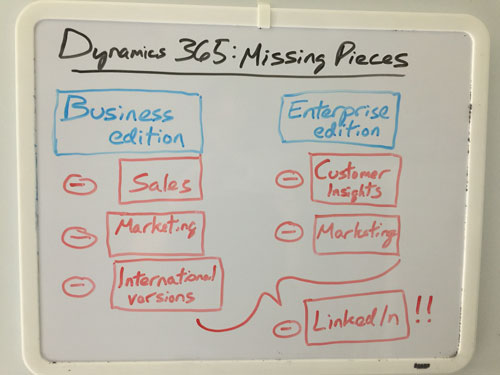 [Click on image for larger view.] Figure 2: Missing Dynamics 365 pieces at launch.
[Click on image for larger view.] Figure 2: Missing Dynamics 365 pieces at launch.
Some of the core components required to light up a lot of Dynamics 365 functionality won't be available immediately at launch.
Probably coming on the Enterprise edition side, there's the Dynamics 365 for Customer Insights application. Based on the Cortana Intelligence Suite, Numoto wrote that Customer Insights, which was unveiled on Tuesday, "connects and analyzes data from Microsoft -- and other widely used CRM, ERP, web, social and IoT sources -- and applies intelligence to it to give you a 360-degree customer view with automatic suggestions to improve engagement." Customer Insights is scheduled for availability in December.
In some earlier documentation, Microsoft listed plans to release a Marketing application for the Enterprise edition, but it's not clear yet what technology that product would be based on. One possibility is the Adobe Marketing Cloud. In an announcement from Microsoft Ignite last month about the partnership, the companies stated that "Microsoft will make Adobe Marketing Cloud its preferred marketing service for Dynamics 365 Enterprise edition, giving customers a powerful, comprehensive marketing service for Microsoft's next generation of intelligent business applications." Mordue blogged separately last week that he's been told by Microsoft that the Marketing app has been canceled in favor of using Adobe. RCP hasn't been able to confirm that with Microsoft yet.
On the Business edition side, Microsoft also has placeholders for business applications covering Sales and Marketing. The Business edition will also only be available immediately in the United States and Canada. Versions for other geographies are all coming later.
There was little mention this week either about what role Microsoft's LinkedIn acquisition might play in the Dynamics 365 lineup. Given the obvious advantages of LinkedIn's professional social network platform and data for CRM, it's safe to assume substantial integration in the future.
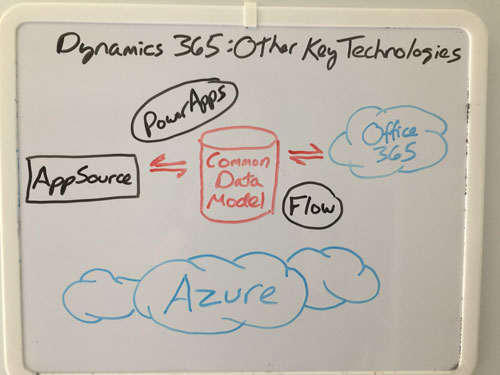 [Click on image for larger view.] Figure 3: Other key Dynamics 365 technologies.
[Click on image for larger view.] Figure 3: Other key Dynamics 365 technologies.
While the availability of the discrete business applications will be critical to unlock much of Dynamics 365's promise, there are other Microsoft technologies that undergird, connect and integrate the Dynamics 365 applications and solutions. Some, like AI, Internet of Things and chatbots will become more important later. There are a few that Microsoft is using already on a broad basis across the suite.
Microsoft's Azure public cloud has a starring role -- it's the platform on which all of the Dynamics 365 products and functions are being built. Other technologies being touted heavily by Microsoft right now that partners and customers will need to understand to get the most out of Dynamics 365 include:
- Common Data Model: Microsoft's out-of-box business database for storing and managing business entities.
- PowerApps: Microsoft's service for building and using custom business apps that connect to data and work across the Web and mobile.
- Flow: Microsoft's SaaS offering for automating workflows across business users' applications and SaaS services.
- AppSource: A marketplace for partner applications.
- Office 365: Microsoft's SaaS-based productivity suite, which is heavily integrated with Dynamics 365.
The technologies Microsoft will roll out as Dynamics 365 on Nov. 1 represent a big step forward in Microsoft's business applications story. But it looks like it will be mid-2017 or later before some important elements become available.
Posted by Scott Bekker on October 14, 20160 comments
As Hurricane Matthew churned toward the Florida coast Thursday afternoon and residents of the southeastern United States evacuated, disaster and recovery vendors spun up emergency programs to help unprotected businesses with last-minute efforts to save their data.
Matthew was expected to make an extremely close approach along the Florida coast Thursday night as a Category 4 or even possibly a Category 5 hurricane. Although it was not expected to make landfall, Matthew's storm surge and winds could still wind up being more devastating than a more typical hurricane strike.
As the National Weather Service put it Thursday morning in its hurricane statement, "Widespread extensive to devastating wind impacts will be felt. ... Effects such as these ranging from the coast to well inland have not been experienced in central Florida in decades."
Exacerbating the problems is an overall weather pattern that is currently expected to bring the storm in a looping pattern back off the Florida coast after lashing Georgia and South Carolina, with the potential for even longer power outages due to the potentially extended battering.
Axcient Inc. and StorageCraft Technology Corp. were among vendors who announced free emergency help for companies that needed to back up data.
"In the face of Hurricane Matthew, we are offering complimentary, no-commitment disaster recovery and data protection services to businesses who could be impacted," said Axcient CEO Justin Moore in a statement. The offer to back up data to Axcient's cloud-based recovery service, Fusion, "is valid for up to 30 days or until the impacted business is stabilized, whichever is longer," he said.
StorageCraft set up an emergency URL, storagecraft.com/storms, where businesses and non-profits in Florida, Georgia, South Carolina and North Carolina could begin the process of backing up data for free with StorageCraft ShadowProtect SPX software.
"The best way to ensure business continuity after the storm is to prepare before the storm," said Curt James, vice president of marketing and business development at StorageCraft, in a statement. "ShadowProtect SPX gives IT professionals a chance to back up, and reliably recover, their critical systems and data quickly. This will allow them to focus even more time on safeguarding their businesses and families as the storm approaches."
StorageCraft's offer gives users 15 days to back up systems and data, and those who back up data by Oct. 14 will be able to recover the data for free.
Posted by Scott Bekker on October 07, 20160 comments
High-profile Microsoft partner Christopher Hertz is stepping down from New Signature, the two-time Microsoft United States Partner of the Year company that he founded 13 years ago.
Hertz has been president of the fast-growing, Washington, D.C.-based company since April 2015, when New Signature landed a $35 million venture capital investment from Columbia Capital, which brought in a new chairman and a new CEO.
In a statement, New Signature said Hertz was stepping down as president "to focus more time on family, personal interests and future opportunities." According to the company, Hertz had been working with CEO Jeff Tench on the transition and this week moves from his active management role to an advisory role. His official last day as a New Signature employee is set for the end of the month.
"I have the utmost confidence and belief that New Signature will continue to be incredibly successful," Hertz said in a statement. "It is with tremendous pride that I hand over the reins to a very capable team, led by Jeff Tench, CEO and Neil Hobbs, Chairman. As a shareholder, I look forward to watching the company grow and shine. As an alumnus, I will continue to be a fanatic and evangelist for New Signature."
Microsoft has featured Hertz regularly at the Microsoft Worldwide Partner Conference (WPC) and at its internal sales meeting, Microsoft Global Exchange (MGX). He has had WPC speaking slots from 2012 to 2015, including onstage roles in the heavily attended North American keynotes in 2014 and 2015, according to his LinkedIn profile.
Posted by Scott Bekker on October 07, 20160 comments
The overhauled partner program that StorageCraft Technology Corp. executives promised earlier this year when the company got its $187 million private equity investment went live on Wednesday.
"Really as you look at it -- the way the company is changing, the expansion of the product line -- we kind of knew it was time to really revamp the entire partner program," said Marvin Blough, vice president of worldwide sales and one of several veteran technology executives brought in after Chairman and CEO Matt Medeiros joined the Draper, Utah-based company in January.
StorageCraft created a partner advisory board in May, and feedback from those partners helped lead to several significant changes, Blough said in a telephone interview.
The most visible change is taking the StorageCraft Partner Network from a single-tier program to one with four tiers -- platinum, gold, silver and authorized. Membership levels are determined based on a new certification component and to a lesser extent on revenues, Blough said.
A newly launched partner portal includes e-learning modules for both sales training and technical training. Those resources are free, although partners can pay for face-to-face training. The sales training takes about four hours. Technical training for a new Engineering Certification takes about 20 hours and is the cornerstone of the new tiers. A silver partner needs one certified engineer, while gold takes two certified engineers. To reach platinum, one of those two engineers required for gold needs to hit a higher "master" level.
In order to acknowledge the experience of longtime partners, technicians can test out of some of the training.
"If you go through and take the test, and you don't pass it, it will tell you which parts you are weak in, and which parts you're strong in. There may be 20-hours of classes, but realistically if you went through and took the tests, you could say, 'I don't need to take those eight hours of classes, but I do need to take these six to eight hours of classes,'" Blough said.
Among the benefits of moving up in the tiers are joint marketing development funds, deal registration and additional points of margin. Broad benefits that apply to all tiers include beta software, not-for-resale software, marketing materials, and access to purchase and renew licenses through the self-service portal.
Last month, StorageCraft refined its focus by acquiring Gillware Online Backup, which will help StorageCraft partners develop consultative relationships around backup in which they can help customers prioritize how data gets backed up.
The company is developing training modules for later delivery around the Gillware technology, as well as around a StorageCraft Cloud to Cloud data protection solution for Microsoft Office 365, Google Apps, Salesforce.com and Box that is currently scheduled for availability in December.
Posted by Scott Bekker on October 05, 20160 comments
Satya Nadella and Brad Smith kicked off a Microsoft campaign to shape the global debate on technology policy with a joint keynote in Dublin, Ireland, Monday morning and the release of a policy book containing 78 specific recommendations.
At a base level, Microsoft's interest in the global policy debate around the future of the cloud has to do with protecting its multibillion-dollar investment in a public cloud infrastructure and trying to maximize the opportunity for those datacenters to store and serve data and computing power to customers in as many countries as possible.
Nadella made a higher-minded case for the company's involvement in his speech. "With any new technology like the cloud, one of the profound things that happens is change, and rapid change and disruptive change. And so it is incumbent on companies like Microsoft and the broader tech community and governments to have that dialogue where we look at this new technology and ask ourselves the question: 'Is this technology truly going to benefit everyone on the planet? Is this technology that is helping to solve some of the pressing issues, whether they be in education or in health care?'" said Nadella, Microsoft's CEO since 2014, whose main slogan during his tenure has been "cloud-first, mobile-first."
On stage, Nadella held up Microsoft's contribution to that discussion in the form of a book called "A Cloud for Global Good," which Microsoft posted online Monday morning. "That is a concrete step that we are taking to propose a set of ideas, a set of policy considerations, for broader discussion so that we can come up with ways that these disruptive technologies can help global growth in a way that is more trusted, more responsible and more inclusive," he said.
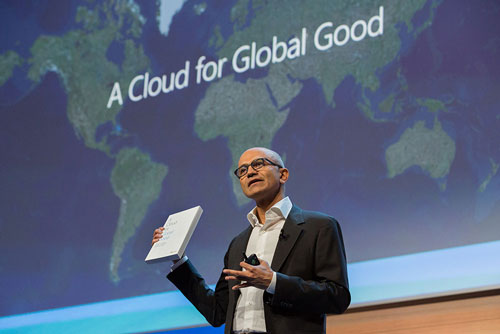 Microsoft CEO Satya Nadella holding a copy of "A Cloud for Global Good" during Monday's presentation.
Microsoft CEO Satya Nadella holding a copy of "A Cloud for Global Good" during Monday's presentation.
The first chapter of Microsoft's book sets up the positive and negative futures the cloud could enable:
The potential is so vast that some are already calling it the Fourth Industrial Revolution. The benefits could be enormous. It's now possible to imagine a not-too-distant future in which poverty has all but been eliminated, diseases that have plagued mankind for millennia have been eradicated, a solution for climate change has been found, and new forms of communication and collaboration have unleashed creativity and innovation on an epic scale.
But it's also possible to look at the same technological revolution and wonder if we may be headed toward a darker future in which robots and automation drive millions of people out of the workforce, income inequality becomes an unbridgeable chasm, public safety is constantly under siege, and privacy is undermined by intrusive surveillance and the uncontrolled collection of personal information.
Microsoft's recommendations fall into 15 categories: personal privacy, government access to data, cross-border data flows, secure and reliable cloud services, international cybersecurity norms, modern cybercrime prevention, balancing human rights and public safety, technology fraud and online exploitation, environmental sustainability, artificial intelligence, affordable and ubiquitous access, digital literacy, developing next-generation skills, including people with disabilities, and supporting businesses of every size.
Smith, Microsoft's president and chief legal officer, has taken the lead for Microsoft in advocating for cross-border flows of data, for individual rights to data access and for limitations on state surveillance powers.
"It's about ensuring that the kinds of traditional protections that we've all had, not just for years but for centuries, for information that was stored on paper, actually persists for information that is stored in the cloud," Smith said during his keynote.
Also on Monday, Microsoft announced that it had spent $3 billion in Europe alone on its public cloud datacenter buildout and that it would be opening datacenters in France in 2017.
Posted by Scott Bekker on October 03, 20160 comments
Microsoft this week at its Ignite show in Atlanta unveiled several new regions for the Azure public cloud, opening its first two regions in privacy-conscious Germany and pinpointing plans for four more regions around the world.
Microsoft Azure is the second-largest global public cloud by customer revenues, according to independent analyst estimates, and Microsoft now claims an Azure presence in twice as many regions as the public cloud market-leading Amazon Web Services (AWS).
"Over the last several years we've been hard at work expanding it to run literally all over the world," said Scott Guthrie, executive vice president for the Microsoft Cloud and Enterprise Group, in an Ignite keynote Monday. "We now have 34 unique Azure regions around the world."
Guthrie described Azure regions as clusters of multiple datacenters that are geographically close to customers to allow them to access data and computing power faster.
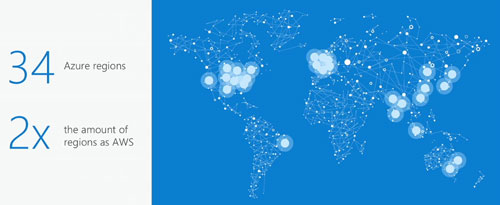 [Click on image for larger view.] Guthrie's keynote included this slide showing Microsoft's Azure regions worldwide.
[Click on image for larger view.] Guthrie's keynote included this slide showing Microsoft's Azure regions worldwide.
The list includes 30 generally available regions, including a pair that just opened in Germany, where Microsoft previously didn't have a presence.
"The Microsoft Cloud is also the only [global] cloud vendor licensed to operate legally in China, and the only to offer full data sovereignty in Germany, using our data trustee model," Guthrie said.
To meet German data sovereignty requirements, data in the new regions in Frankfurt and Magdeburg will be under the control of T-Systems, a Deutsche Telekom company acting as the German data trustee. Those new datacenters bring Microsoft's European Azure region list to six, joining Ireland, the Netherlands, Cardiff and London.
Guthrie's total of 34 also includes four regions that are in the development stage but are not yet online. Those are a U.S. Department of Defense East and a U.S. Department of Defense West, as well as two regions in South Korea.
Amazon categorizes its public cloud AWS infrastructure differently and, like Microsoft, positions its datacenter coverage in a light favorable to the physical investments the company has made. While it currently lists 13 regions worldwide with four more in the works, Amazon can make a case that the 35 entities within those regions that it calls availability zones are similar in some ways to what Microsoft calls regions. Although Azure currently has a regional presence in 12 countries, AWS is close behind in 10. Both Microsoft and Amazon detail the global scope of their datacenter infrastructure here for Azure and here for AWS.
Posted by Scott Bekker on September 27, 20160 comments
Dell on Thursday unveiled a refreshed line of mobile thin clients based on the Latitude family of laptops.
The Dell Latitude E7270 and the Dell Latitude 3460 will both be available on Oct. 4. While these new clamshell-based devices are mobile thin clients, the bulk of thin client demand is expected to continue to be for desktop devices, said Dan O'Farrell, senior director of product marketing for Dell Cloud Client-Computing.
"[We have] a lot of flavors of thin clients or what we call zero clients. Our goal is to make it as easy as possible for organizations to furnish the right devices," O'Farrell said. Industries in which mobile thin clients tend to be especially appropriate include finance, health care, government, manufacturing and the energy and exploration sector, he said.
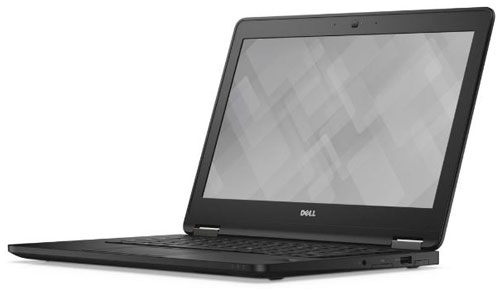 The Dell Latitude E7270 is a "corridor warrior" mobile thin client powerful enough for local use of CAD/CAM applications.
The Dell Latitude E7270 is a "corridor warrior" mobile thin client powerful enough for local use of CAD/CAM applications.
The E7270 is the higher-end of the two devices, with enough horsepower to handle local rendering for CAD/CAM applications, while still portable enough with a 12.5-inch screen and a weight of 2.77 pounds. O'Farrell described the device as appropriate for a "corridor warrior," someone who roams to different work areas inside an office complex rather than necessarily leaving the premises with the device.
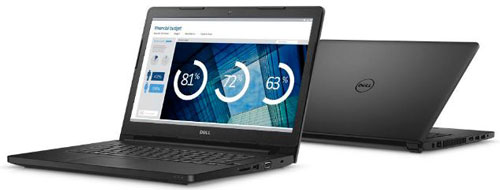 The Dell Latitude 3460 is one of two new mobile thin clients from Dell that will be available Oct. 4.
The Dell Latitude 3460 is one of two new mobile thin clients from Dell that will be available Oct. 4.
The Latitude 3460 is designed for knowledge workers with use cases where it's important for regulatory or legal reasons that the data accessed on the device be locked down, he said.
Both devices will ship with Windows Embedded Standard 7 64-bit. Although Microsoft offers a Windows 10-generation operating system for thin clients, O'Farrell said the Windows 7 version is "the sweet spot for companies right now."
The mobile thin clients are deployable and manageable with Dell's Wyse Device Manager or with Microsoft System Configuration Manager. Dell is also offering Dell Data Protection | Threat Defense as an option for advanced threat protection of the mobile thin clients.
Posted by Scott Bekker on September 22, 20160 comments